
views
Brainstorming

Choose an inspiring place. Developing your bucket list should be exciting, so find a place to brainstorm that inspires you! You might pick your favorite park, a cozy corner in your house, or a coffee shop.

Choose goals that are meaningful to you. Your bucket list should contain items that are deeply meaningful to you. Don’t include items simply because you feel you should, or because others would find them impressive. What are your dreams? What brings you fulfillment? Consider childhood passions that have fallen to the wayside. These can be a good indicator of things you value, but haven’t had the time or resources to pursue. Think about achievements that have given you the greatest confidence, and activities or moments that have brought you the most passion or joy.

Find a common theme. As you brainstorm within these categories, look for a common theme and use it to guide the creation of your list. For example, if your happiest moments have been helping others, then choose bucket list items, like starting an after-school program for underprivileged kids, that align with that theme.

Cast off expectations. Don’t worry about others judging you, or not achieving certain items. Listen to what you truly want. Are there any goals that you’ve secretly wanted to pursue, but never have because you were embarrassed? Consider including those. If you don’t achieve all of the goals on your list, that’s fine! A bucket list is a guide, not a binding document.

Talk to others for inspiration. If you are feeling stuck, reach out to friends and family. Ask them about the items on their bucket lists and their favorite life experiences. Ask, “What is the coolest thing you have ever done?” or “If you could do one thing before you die that you’ve never done before, what would it be?” Feel free to research online for fun ideas, too!
Writing Your First Draft

Choose your medium. You can document your goals on a piece of paper or on your computer--the important thing is that you write them down. Writing down a goal increases your likelihood of achieving it.

Write down every idea. Take at least 15 minutes, and jot down every idea that comes to you. Don’t be embarrassed or self-conscious--just write! This is your chance to get everything out. You can edit later. Keep the ideas from your brainstorming session in mind. Try starting with the question, "If you only had a year left, what would you want to do?" Think about places you want to visit, skills you want to learn, activities you want to try, and people you want to meet.#*Just like with brainstorming, the best writing is done in an inspiring place! You can stay in the same location you used for brainstorming, or pick a new one.
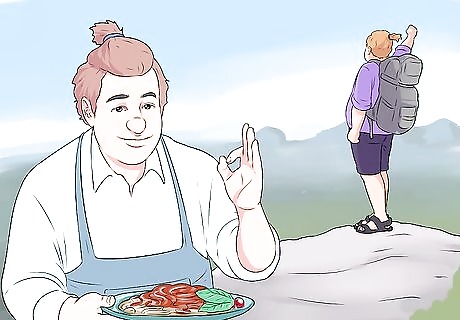
Include a combination of large and small goals. Of course, your bucket list should have big, challenging goals, but it’s good to include smaller goals, too. Not only can smaller goals be rewarding, by they’ll make your list more manageable, inspiring you to get out there and check some items off! You can think of small goals as those that can be accomplished without leaving your town on a budget of less than $100. For example, a small goal might be making pasta from scratch.

Think for a while before you edit. It’s best to wait a bit before you begin to edit your list. Allow yourself to think about each of your items. Make sure each item is meaningful.
Editing and Organizing Your Bucket List
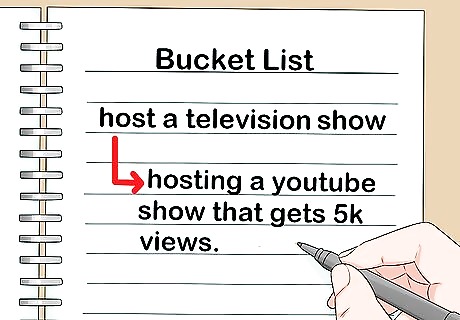
Break big goals down into easier and harder variations. You might want to host your own television show one day. Put that down. Then, include an easier variation of that goal, like hosting a YouTube show that gets 5K views. The easier variations can act as stepping stones to the harder goals. Do you want to write a novel? Start with publishing a short story in a local literary magazine. If one of your goals is to open a bakery, you could start by running a successful baked goods stand at your local farmer’s market.
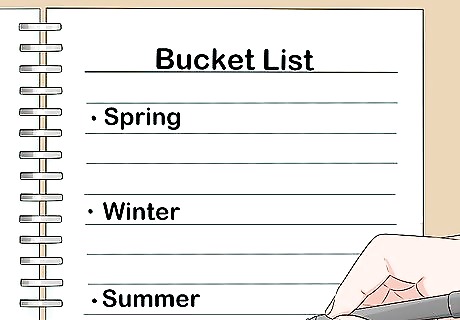
Group items by time. Looking at all of the items on your lifetime bucket list may be overwhelming. This can lead to inaction. Short-term goals are less daunting, so try breaking up your list by time periods. You can break it up by decades, years, or seasons. For example, you might have mini bucket lists for your 20s, 30s, and 40s. Or, you might make a bucket list just for the summer. It’s completely up to you. Choose a time scale that seems most manageable.
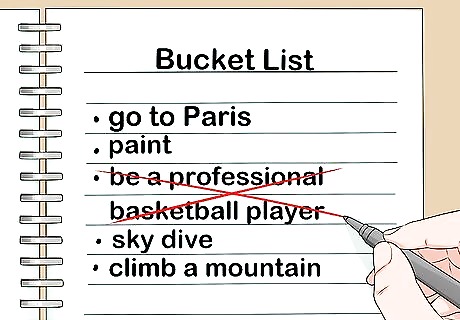
Remove unrealistic items. You bucket list may--and should--include items that seem difficult to achieve. The challenge of the bucket list is part of its beauty. That being said, you should remove any items that are completely unrealistic. Your list should contain items that are hard, but not impossible, to achieve. For example, if you are a 50-year-old man with limited athletic experience, you will probably never be a professional basketball player. However, you might be able to win the championship in a local club league with practice. You shouldn’t remove an item just because it is expensive. Expensive goals can be achieved in creative ways.
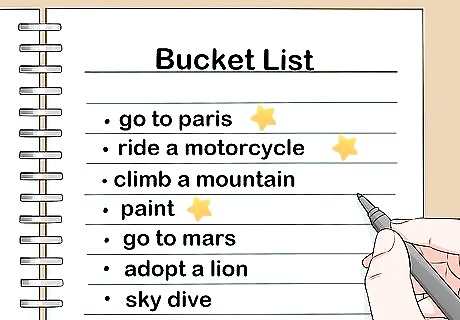
Prioritize 3 items. Go through your list, and place a star next to the 3 items you want to work on first. It’s a good idea to start with the items that excite you the most. If any items have a time limit, prioritize those.

Review your list frequently. People are always growing and changing. Likewise, some of the things that are important to you may change over time. Your list should be flexible. Allow it to evolve as you do. A relevant list will help you stay motivated. Set aside some time each week to go over your list. Add or remove items if necessary, and begin to plan how to make one or two items a reality.
Sharing Your List
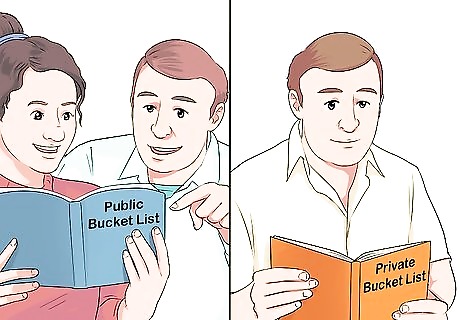
Identify public and private goals. You may want to share many of your goals with the people you care about, but others may be more private. That’s ok--you don’t have to share all of them. Determine in advance which goals you feel comfortable sharing, and those you don’t.

Share the public items on your list with others. Share your public list with loved ones. By sharing your list with others, you are expressing a new level of commitment. Your loved ones can hold you accountable and offer support, prompting you to take action. Share your list with people who are optimistic and supportive. Pessimists can drag you down. Consider working through some of your bucket list goals with a loved one. Checking off an item with a loved one can be even more rewarding.

Find others who are working through their bucket lists. Motivation and inspiration are contagious. In other words, you can gain motivation by surrounding yourself with motivated people. Find people who are passionate about their bucket lists and get to know them. They’ll be able to give you new ideas while inspiring you to achieve the goals on your bucket list.




















Comments
0 comment